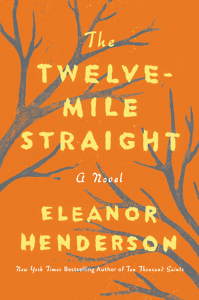Two Nations in Thy Womb
The arrival of mixed-race twins stirs local violence in Eleanor Henderson’s The Twelve-Mile Straight
Eleanor Henderson’s new novel, The Twelve-Mile Straight, opens with a Biblical epigraph that evokes the moment in Genesis when Rebekah’s distress during her pregnancy with Jacob and Esau elicits a message from God about the direction history is about to take: “Two nations are in thy womb.” Through this powerful origin story, the babies “struggling within her” are already affecting the larger course of events. In Henderson’s novel, the surprising appearance of twin newborns—one dark-skinned, the other pale and freckled—likewise creates upheaval in a Depression-era South Georgia community, sparking a lynching and a legacy of insidious consequences.

The Twelve-Mile Straight marks a notable departure in subject from Henderson’s first novel, 2011’s lauded Ten Thousand Saints, which featured the thrills and vagaries of youth culture in 1980s New York. As Henderson writes in her author’s note, this new work draws from her father’s bucolic tales of his own rural Southern upbringing—a legacy she has sought both to illuminate and to “fracture.” Consequently, this novel explores the far tougher lives that less privileged neighbors must have been living alongside her own family’s relative good fortune.
The book’s title refers to the story’s central setting, a flat stretch of road in South Georgia that runs alongside abundant creeks and connects hundreds of acres of farmland—largely cotton, which support the Wilson family’s cotton mill. The Wilsons’ primary sharecropper, Juke Jesup, has developed a popular moonshine infused with the white flower of the cotton plant, and despite the pressures and subterfuges created by Prohibition, Juke’s product is thriving even as King Cotton’s are wavering. Because of his community service (and liquid bribes), Juke’s “soft spot for colored folks” tends to be overlooked in the white community. Then Juke’s only daughter, Elma, gives birth to illegitimate twins—the boy notably dark-skinned and the girl notably pale.
The questions this event raises quickly turn to outrage, and then to violence. Genus Jackson, a field hand living in a shack beside the Jesups’ house, is brutally lynched at the hands of local men, hanged in a “gourd tree,” shot multiple times, dragged from a pickup truck, and left dead and exposed on the road. According to the official story, however, there was no lynch mob: Genus Jackson’s sole killer was Freddie Wilson, respectable grandson of the mill owners and reluctant fiancé of Elma Jesup.
After Freddie flees town, the local sheriff can’t get anywhere near the truth of this event. Though he has never had to investigate a lynching in Cotton County, he is familiar with the stonewalling involved in such crimes: “A hill of men, too many to count, too many to haul in, too many most times for a sheriff to do anything about except throw up his arms. But in all his years he’d never seen a mob finger one of its own.”
 The weight of culpability for this terrible violence—and for other acts of violence revealed along the way—hovers over the central characters of The Twelve-Mile Straight. The Jesup household is held together by layers of secrets that appear to poison and corrupt everyone they touch. Henderson wastes no time in laying out the truth of Genus’s lynching, and one result of this revelation is a novel frontloaded with multiple points of view, some of them tough to read compassionately.
The weight of culpability for this terrible violence—and for other acts of violence revealed along the way—hovers over the central characters of The Twelve-Mile Straight. The Jesup household is held together by layers of secrets that appear to poison and corrupt everyone they touch. Henderson wastes no time in laying out the truth of Genus’s lynching, and one result of this revelation is a novel frontloaded with multiple points of view, some of them tough to read compassionately.
Fortunately, one of them is that of a young black housemaid named Nan, who was raised alongside Elma. Nan breathes life and heart into the story at just the right moment, deepening and widening the scope of the novel’s vision. In childhood the two girls—both motherless—shared an intense, troubled kind of Southern bond—ostensibly familial but inevitably frayed by racial hierarchy. Before her own death from a family propensity for mouth cancer, Nan’s mother cut out her young daughter’s tongue, hoping to give her a better chance for survival. As a result Nan became even more dependent on the Jesups, at least during her youth, when Elma communicated for them both. Now valued as a local midwife, Nan has begun to imagine a life outside Cotton County, but the appearance of Genus, and the subsequent arrival of the two notorious babies, complicates her plans immeasurably.
Henderson has a grand ambition for The Twelve-Mile Straight. Weighing in at more than 500 pages, the novel roams over a vast and complex territory, upending our expectations for its characters numerous times. Though many of the events and characters could easily have fallen into well-worn Southern archetypes of the Depression era—too often sentimentalized by white authors—Henderson makes the tougher choice and thereby creates a kind of heartbreaking, long-form act of reckoning. The pastoral stories may be fractured, but those fractures let in much-needed light and air.

Emily Choate holds an M.F.A. from Sarah Lawrence College. Her fiction has been published in Shenandoah, The Florida Review, Tupelo Quarterly, and The Double Dealer, and her nonfiction has appeared in Yemassee, Late Night Library, and elsewhere. She lives in Nashville, where she’s working on a novel.


